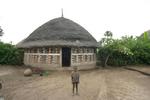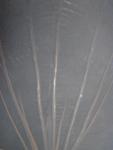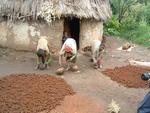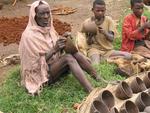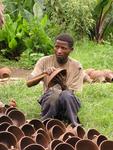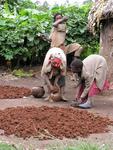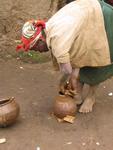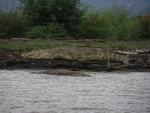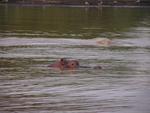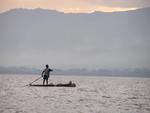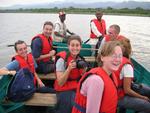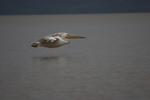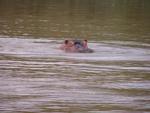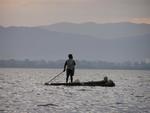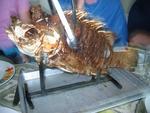Although not hot, it was relief to be able to have a shower in the
morning. The previous night, there had been no water. The water
itself felt very greasy, possibly coming straight from the lake.
The rain decided to join us again as we drove to Sheshemane, quaintly
known as the "Fuck you" capital of Ethiopia. It has a reputation of
high levels of verbal abuse. I didn't notice that much even when Ali
and I went to a photo shop to try to buy a replacement battery for
her camera.
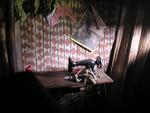 |
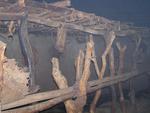 |
The continuing drive was on a long, straight tarmacced road. The
surrounding fields were full of cultivated crops and the cars went
over several clanking metal bridges above rivers with flowing water.
It wasn't long before we had stopped off at another hut. A
distinguishing feature of this hut was the well. Rather than charge
straight inside, I decided to wait around outside for a bit and I
found that I could do a useful job of distracting the children
so that the others could get in and have a decent look. Once I had
got inside the large circular hut I could immediately see the sewing
machine - a sign of wealth. Although the hut was large, nine
children lived inside. On the walls small pieces of pink paper
were stuck with words written in fidel, presumably to help the
children learn. As if having nine children wasn't enough, an area
of the hut was also set aside for animals.
As we continued our drive, Jackie commented on something her
parents had said to her when they visited recently. They had seen
lots of people walking and had asked where they were going. Although
this was a perfectly sensible question it seemed odd to us. Firstly,
how would we know where people were going? Secondly, they found
it hard to accept that people have to walk everywhere. Cars are rare,
bikes aren't actually that common, and horses are not often used for
riding. What prompted the comment was large numbers of people walking
along the roadside. Some where children on their way back home after
the morning 'teaching shift'. Most were adults going to a market
somewhere, goods strapped onto the back of most women, and the
occasional man.
Our next stop was at the hut of a potter. Talking to Firew it seemed
that potters are treated like blacksmiths - not very well. Because a
potter does things and makes things with their hands, they are seen
as lowly because they have to work. It seems the ultimate task is
to not actually do the work and this gives you a higher status. Now
this is undoubtedly wrong and an oversimplification but it brings me
a bit closer to understanding some things about Ethiopian culture.
People who get off their arses and do some work are not respected
unless they have made it to a position of power. This has reinforced
my believe that circuit training will be the most positive thing
we have done with the students. If it gives them the mental toughness
to get over the 'stigma' of working and they can go beyond it and
achieve, then that will be one of the most useful skills they possess.
In front of the potter's hut lay different types of clay and many clay
pots drying in the sun. It seemed to be that the men were finishing
the pots by giving them a smooth surface and the women formed the
shape of the pot from the clay. This they would do by first getting
a lump of clay and putting it on the floor. Then, bent over to reach
the ground, they would walk in a circle around the developing pot.
An English potter would have a wheel to spin the pot, here the ladies
spun themselves around the pot.
A short distance from the potters we could see trenches dug into the
road side. The trenches were about 0.5m by 2m and 0.5m deep. They
seemed to be the source of their clay. Slightly further the
immediate scenery changed dramatically into deeply cut furrows from
water erosion. Weird shapes and patterns could be seen in the
ground. In front of these patterns often stood small, regular
palettes of firewood, although never anyone next to them actually
selling them. A little bit further the road had many very small bamboo
huts, which we guessed were for selling goods.
Our lunch stop brought us to Sodo. Although the sandwhiches yesterday
had been good, we surprised Firew by asking for Habesha food. Being
a Wednesday, we could get bayentu, a fasting food. Like much Ethiopian
food, enjera forms the staple part, but there is a good variety of
different sauces and whatever vegetables are available. This makes it
a good option when eating habesha food.
Things had been getting green again as we approached Sodo, now we
could see many banana tree plantations and false banana trees. I'm
not quite sure how to tell the difference - they look similar -
but I think a real banana tree is considerably shorter (and has
bananas obviously). The false banana trees are used even though
they do not bear fruit. Part of the tree is buried in the ground
to make it go soft, and it is then groud up to make a kind of
bread. I have had this before with kitfo (raw meat) and I have
to say that McDonalds shoud deriously look at it. It is more
cardboard like than their fries and probably cheaper to produce.
Our final destination for the day was Arba Minch, and as we approached
banana plantations and cotten farms dominated the landscape with
a large textile factory a short distance from the town.
Although Arba Minch was the destination, it was the lake we were
most interested in. Definitely no swimming here though - crocodiles.
Arba Minch has two lakes close to it. Lake Abaya we could see from
our hotel, however, lake Chamo was our destination because of the
crocodile market. The arabs had once again joined us. We had set off
without them in the morning because they weren't keen on the 07:30
start time on driving. Their car could also travel much faster than
either of ours.
The trip down to the lake took us along gravel roads winding and
dipping along the side of mountains until we reached a turning
that took us off of the main road and into a wooded area. Behind us,
a line taxi had been following for some time which was odd because
there wasn't really any stops to make it a line taxi route. It
became clear that it was following us when it too left the good
road to join us on the dirt track. On board were people to help
us at the lake, presumably arranged by Firew. The dirt track
divided and rejoined continually, navigating its way around trees
and ruts that were too deep for vehicles. At one point we were stopped
by a herd of cows. In charge of the cows a strikingly beautiful girl
whose only piece of jewelry or accessory was half a comb in her
hair.
As we stepped out of the cars close to the river side dragon flies
came to investigate, hovering about 50cm from the ground. We were
issued life jackets which came as a surprise to us but we were
quite happy to put them. I must admit I was wondering if they were
a bright red to make us more attractive to the crocodiles
if the boat capsized. To get to the boat we had to walk along a
small jetty made from what looked like eucalyptus poles (long, thin
and straight). It was quite a challenge because they were not all
fixed in place and not only did you have yourself to contend with
but other people on the jetty could cause the place you were
going to put your foot move unpredictably. It was a relief that
we had our own boat, for all we knew the arabs had been out to
kill a monkey to feed the crocs (not true though).
The boat (motorized) moved out smoothly and it wasn't long before
we saw large storks, pelicans, and fish eagles. And then, there they
were, lazing about the banks of the lake - crocodiles. They seemed
large but uninterested. Apparently it was not the time that they
liked to eat but it wouldn't do to be here for too long.
The birds were great to watch, especially the flight of the pelicans.
They would fly in a line, very close to the water. It seemed that
they would flap for just three wing beats and then glide for a bit.
Each bird flapped at the same point (not time) so it appeared
that there were moving in a wave shape (sine wave if you're
mathematical). It was very graceful.
A little bit further we saw another resident that we wanted to visit
- hippos. We couldn't get too close incase they got spooked and that
would really cause us problems. Having said that, we did have one walk
underneath us, somebody spotted the small bubbles moving at a
slow walking pace. The pilot took us away from the area gently.
The lake was a very relaxed place. It was quiet out on the water and
you couldn't help feeling priviliged. The pilot was relaxed enough
to point out that one of the hippos was having a crap which he found
very amusing. We weren't the only boat on the lake. It is also
fished and as we returned to shore we could see the small, one man
fishing boats returning for the evening.
After making our way over the shifting jetty we were offered
crocodile teeth for sale by some boys waiting for us. I was surprised
by how hollow they were. I'm not sure whether some of the insides
had been removed.
Our meal for the evening was at a fish restaurant. A huge, cooked Nile
Perch was placed at our table, made upright by its presentation
stand. Unfortunately they decided to put it in front of the
vegetarians. In fact, two of these fish were brought out but as we
found out, one was just for the arabs. There was so much meat on it
that this suited us fine. Fish can be bought in Mekelle but it is
expensive and depends on supply and whether the electricity has been
on for long enough. Having said this, 'Jon Fish Shop' is now open.
